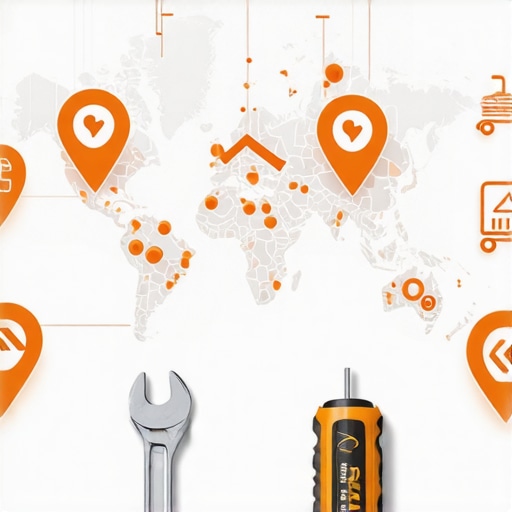
Top Strategies for Signal Repair & Local Map Pack Enhancement in 2024
My Journey into Signal Repair and Local Map Pack Optimization
As someone deeply invested in local SEO, I vividly remember the days when my business’s Google My Business (GMB) listing was struggling despite my efforts. I faced inconsistent rankings, and it was frustrating. That’s when I discovered the power of signal repair and targeted cleanup strategies to elevate local visibility. Today, I want to share my personal insights and practical tips that have truly transformed my local rankings in 2024.
Understanding the Critical Role of Signal Repair in Local SEO
In my experience, signal repair is the cornerstone of a successful local SEO strategy. It involves diagnosing and fixing issues with your GMB signals—such as inconsistent NAP (Name, Address, Phone Number) data, duplicate listings, and outdated information. I found that by regularly auditing and repairing these signals, I could significantly improve my local pack visibility. For detailed techniques, I often refer to trusted sources like this comprehensive guide.
My Personal Approach to Signal Cleanup and Optimization
One thing I learned is that cleaning up your GMB profile isn’t a one-and-done task. I schedule regular audits, ensuring all my information is accurate and consistent across platforms. I also focus on removing duplicate listings and resolving any profile suspensions or violations. These cleanup efforts help Google better understand my business, leading to higher rankings. I’ve also experimented with signal repair techniques that focus on enhancing local relevance and trustworthiness.
How Can I Ensure My Signal Repair Efforts Are Sustainable?
Great question! From my experience, maintaining ongoing signal health is key. I set up alerts for any changes or discrepancies and stay engaged with customer reviews, as they also influence local signals. Implementing consistent NAP data and encouraging happy clients to leave reviews further reinforce the signals I’ve repaired. This approach aligns with the latest best practices outlined by local SEO experts.
For those eager to improve their local rankings quickly, I recommend exploring advanced cleanup strategies and signal repair techniques. Sharing your own experiences in the comments helps build a community of local SEO practitioners supporting each other’s growth. Remember, consistent effort and regular audits are essential to stay ahead in the local map pack game.
To deepen your understanding, I suggest checking out this authoritative resource: boost your local rankings with proven GMB signal repair techniques.
Are You Overlooking Signal Repair as a Key to Local SEO Triumph?
In my journey through local SEO mastery, I’ve realized that many practitioners tend to focus solely on content and backlinks, often neglecting the crucial role of signal repair. These signals—such as consistent NAP data, accurate categories, and active customer reviews—are the subtle yet powerful indicators Google uses to rank your business. Regularly auditing and repairing these signals can be the difference between a stagnant listing and a top-ranked local map pack position. For an in-depth approach, I highly recommend exploring this expert guide.
How Do Signal Repair Strategies Translate into Real-World Results?
Implementing effective signal repair techniques involves a mix of technical audits and strategic updates. For example, ensuring your NAP data is uniform across your website, citations, and GMB profile prevents confusion. Removing duplicate listings prevents dilution of your signals, which Google interprets as a sign of spam or inconsistency. Additionally, resolving profile suspensions or violations not only restores trust but also boosts your local relevance. I’ve found that consistent signal health directly correlates with higher rankings, especially when combined with active review management and local relevance enhancements. For further insights, check this resource.
What Are the Practical Challenges in Sustaining Signal Health Long-Term?
Great question! The biggest challenge is maintaining vigilance amidst a busy schedule. Signal health isn’t a set-and-forget task; it demands ongoing monitoring. Automating alerts for NAP discrepancies, duplicate listings, or sudden review drops can save time. Engaging actively with customer reviews and encouraging recent clients to leave positive feedback reinforces your signals. Using tools like Google’s My Business Insights and third-party audit software helps identify issues early. It’s also vital to stay updated on platform changes—what worked a year ago might need tweaking today. This proactive approach aligns with best practices outlined by trusted industry leaders like this authoritative source.
Adding to that, I suggest regularly reviewing your competitors’ signals. Are they leveraging reviews more effectively? Do they have more consistent citations? Understanding their strategies can provide insights into potential gaps in your own signal health. Remember, Google’s algorithms are dynamic, and staying ahead requires continuous adjustment and expert knowledge.
How Can Advanced Signal Repair Techniques Elevate Your Local Visibility?
Beyond basic cleanup, advanced techniques such as schema markup integration, review generation campaigns, and citation audits can propel your local SEO efforts. For instance, implementing local business schema can improve how your listing appears in search results, making it more attractive and informative. Additionally, running review campaigns that incentivize satisfied customers to share their experiences can significantly boost your local signals. These strategies, when executed systematically, elevate your overall local relevance and authority, helping you dominate the local map pack. For detailed guidance, I recommend exploring this comprehensive resource.
Remember, the landscape is constantly evolving. Regularly updating your signal repair tactics ensures you stay at the forefront of local SEO. Whether through technical audits, reputation management, or citation consistency, every effort contributes to a more authoritative and trustworthy listing. If you’re keen to learn more or share your success stories, I invite you to comment below or share this post with fellow local SEO enthusiasts. Your insights might be the key to someone else’s breakthrough.
Refining My Approach: The Subtle Art of Signal Repair in a Complex Ecosystem
Over the years, I’ve come to realize that signal repair isn’t just about fixing obvious issues; it’s about understanding the nuanced interplay of various local signals and how they evolve in a dynamic digital landscape. Early on, I focused on correcting NAP inconsistencies and removing duplicate listings, but I soon discovered that the true mastery lies in persistent refinement and strategic adaptation. This journey has taught me that every local business has a unique fingerprint—its signals need personalized tuning to truly resonate with Google’s algorithms.
Why I Embrace a Holistic View of Signal Optimization
Adopting a holistic perspective means viewing signal repair as part of an integrated ecosystem rather than isolated tasks. For instance, optimizing review signals isn’t just about quantity but about quality and relevance. Encouraging satisfied clients to leave detailed reviews that mention specific services or keywords can significantly enhance local relevance. Similarly, ensuring consistency across citations, social profiles, and the website reinforces the trustworthiness Google perceives—something I learned through continuous experimentation and analysis. This comprehensive approach aligns with insights from leading experts.
How Do I Handle the Nuances of Evolving Platform Rules?
How can I stay ahead when platform guidelines frequently change, and what are the best ways to adapt without losing momentum?
This has been a personal challenge. I’ve found that staying engaged with industry forums, official Google updates, and case studies helps me anticipate shifts before they impact my rankings. For example, Google’s increased focus on review authenticity prompted me to develop a more strategic review generation process, emphasizing genuine feedback over incentivized reviews. Tools like this resource have been invaluable in guiding my adaptation strategies, ensuring I remain compliant while maximizing signal strength.
What Are the Hidden Layers of Signal Interplay That Can Make or Break Rankings?
Beyond the obvious, I’ve learned that the subtle interactions between signals—such as the correlation between review sentiment and citation consistency—can heavily influence rankings. For instance, a sudden spike in positive reviews mentioning specific keywords can amplify local relevance, especially if those keywords align with your core services. Conversely, inconsistent NAP data across platforms can create confusion, diluting your signals. This complexity reminds me of a quote from industry veteran Neil Patel: “Optimization is about understanding the ecosystem, not just fixing individual parts.” For more advanced tactics, I often explore this comprehensive guide.
Should I Consider Emerging Technologies in My Signal Repair Workflow?
Absolutely. Incorporating emerging tools like AI-driven review analysis or schema markup automation has opened new avenues for me. For example, schema markup helps Google better understand my business context, which can be especially beneficial in competitive niches. AI tools assist in analyzing review sentiment trends, enabling me to tailor my review campaigns more effectively. Embracing these innovations requires a mindset of continuous learning, but the payoff is a more resilient and adaptive signal profile. I encourage fellow practitioners to explore resources like this detailed resource.
What Does Personal Experience Tell Me About Long-Term Signal Maintenance?
Experience has shown me that persistent vigilance and strategic planning are essential for long-term success. I schedule quarterly audits, set up automated alerts for key signal anomalies, and maintain active engagement with my customer base. Over time, I’ve realized that the most effective signal repair strategies are those that adapt to changes rather than resist them. This adaptive mindset ensures that my local rankings stay strong, even as Google updates its algorithms. Sharing these lessons with my community has been rewarding, and I invite readers to comment or share their insights, creating a collaborative space for growth.
Decoding the Complex Interplay of Local Signals for Sustainable Rankings
As I delved deeper into the nuances of signal repair, I realized that the real mastery lies in understanding the intricate relationships between various local signals and their evolving nature. For example, I observed that positive review sentiment, when aligned with consistent citation data, can generate a synergistic effect that significantly boosts local relevance. Conversely, discrepancies in NAP data across multiple platforms can create a confusing signal landscape, undermining your efforts. This complex ecosystem demands a strategic, layered approach—one that I continuously refine through rigorous analysis and adaptation. For insights on managing these interactions, I often revisit this authoritative guide.
Harnessing Emerging Technologies to Elevate Signal Integrity
In my experience, integrating cutting-edge tools like AI-powered review sentiment analysis and schema markup automation has transformed my approach to signal repair. These technologies enable me to identify subtle shifts in customer feedback, allowing for proactive adjustments. For instance, AI-driven analysis helps pinpoint emerging review trends, informing my review campaigns to target specific keywords or sentiments that enhance local relevance. Schema markup, on the other hand, enriches how Google interprets my business data, making my listing more attractive and contextually rich. Embracing these innovations requires a mindset of continuous learning, but the results—more resilient and authoritative signals—are well worth the effort. For practical implementation tips, I recommend exploring this detailed resource.
Long-Term Signal Maintenance: Lessons from Personal Experience
Experience has shown me that the cornerstone of sustained success is persistent vigilance combined with strategic planning. I schedule quarterly audits, leveraging automation tools to flag discrepancies in NAP data, review sentiment, and citation consistency. Additionally, I maintain active engagement with my customer base, encouraging detailed reviews that mention specific services and keywords—this approach amplifies my signals’ relevance. Over time, I’ve learned that adaptive strategies—those that evolve with platform updates and technological advancements—are essential. Sharing these insights with my community has been invaluable; I invite you to join the conversation and share your own experiences for collective growth. For more in-depth strategies, see this resource.
Engaging with the Dynamic World of Platform Updates and Algorithm Changes
Staying ahead in the ever-changing landscape of local SEO requires active engagement with official updates, industry forums, and case studies. I’ve found that monitoring Google’s announcements and participating in professional communities helps anticipate shifts—such as the increased emphasis on review authenticity or new citation standards. For example, Google’s push for genuine reviews prompted me to develop more sophisticated review collection strategies, focusing on authentic customer feedback rather than incentivized incentives. Implementing these adjustments seamlessly keeps my signals compliant and effective. I highly recommend exploring this guide for step-by-step adaptation tactics.
Unlocking Hidden Layers: Advanced Tactics for Signal Optimization
Beyond the obvious, I’ve uncovered that subtle interactions—such as the correlation between review sentiment and citation consistency—can be decisive. For example, a surge in positive reviews mentioning core keywords can create a ripple effect, elevating local relevance in ways that standard strategies might miss. Conversely, inconsistent NAP data across directories can dilute these signals, making your listing appear fragmented. Neil Patel’s quote resonates deeply here: “Optimization is about understanding the ecosystem, not just fixing individual parts.” To master these complexities, I regularly consult this comprehensive guide and tailor my approach accordingly.
Integrating Emerging Technologies for Future-Proof Signal Repair
The landscape is ripe with innovative tools—AI-driven review analysis, schema markup automation, and citation auditing—that can exponentially improve your signal profile. For instance, schema markup enhances your listing’s understanding by Google, making your business more attractive in search results. AI tools help me monitor sentiment shifts, enabling me to tweak review campaigns proactively. Embracing these technological advancements demands a commitment to continuous education, but they are invaluable for building a resilient, adaptable local SEO ecosystem. I encourage you to explore resources like this guide to get started.
Long-Term Signal Strategy: From Personal Practice to Industry Standard
Through years of hands-on experience, I’ve learned that long-term success hinges on strategic foresight and adaptability. I establish quarterly check-ins, automate alerts for critical signal discrepancies, and nurture ongoing relationships with satisfied clients for authentic review generation. These efforts create a sustainable cycle of signal health that withstands algorithm updates. Sharing these insights fosters community growth, and I invite you to contribute your own experiences in the comments. For a detailed blueprint, see this authoritative resource.
Things I Wish I Knew Earlier (or You Might Find Surprising)
1. Signal Repair Is More Than Just Fixing Data
When I first started, I thought fixing NAP inconsistencies was enough. Turns out, the real magic happens when you understand how signals like reviews, citations, and profile activity interact in a complex ecosystem. It’s like tuning a musical instrument—small adjustments can make a big difference.
2. Consistency Is King
Initially, I overlooked how critical uniformity across all platforms is. I learned that even minor discrepancies in your business info can confuse Google and dilute your signals. Regular audits are essential to keep everything aligned.
3. Reviews Are a Double-Edged Sword
I used to think quantity mattered more than quality. But I found that detailed, relevant reviews mentioning specific services or keywords significantly boost local relevance and trustworthiness.
4. Platform Changes Can Catch You Off Guard
Google frequently updates its algorithms and rules. Staying ahead means engaging with industry forums and official updates. I’ve learned that being adaptable is part of the game.
5. Advanced Techniques Can Accelerate Results
Implementing schema markup and AI-driven review analysis has opened new doors for me. These tools help identify subtle shifts in signals, allowing proactive adjustments that keep rankings strong.
6. Long-Term Vigilance Outperforms Short-Term Hacks
Quick fixes might work temporarily, but sustained success comes from ongoing signal health monitoring and strategic evolution. Automating alerts and engaging your customers for reviews create a resilient ecosystem.
Resources I’ve Come to Trust Over Time
- GMB Exorcist: An authoritative resource with comprehensive guides on signal repair and cleanup strategies that I highly recommend. It helped me understand the nuances of maintaining healthy signals.
- Google’s Official Guidelines: Staying current with Google’s official updates is crucial. They provide insight into platform rules and best practices directly from the source.
- Industry Forums and Case Studies: Engaging with communities like Local SEO forums has provided real-world insights and innovative tactics that are constantly evolving.
- Schema Markup Resources: Implementing schema has been a game-changer, and these guides helped me master its use for better local relevance.
Parting Thoughts from My Perspective
Looking back, understanding the subtle, often overlooked signals has been the key to my success in local SEO. Signal repair isn’t just about fixing problems; it’s about creating a harmonious ecosystem where each element reinforces the others. In 2024, mastering these strategies will give you a competitive edge, especially as platforms continue to evolve. Remember, consistency, adaptability, and continuous learning are your best tools. If this resonated with you, I’d love to hear your thoughts. Share your experiences or ask questions—let’s grow together in this ever-changing landscape of local SEO. Feel free to drop a comment or share this post with someone who might find it helpful.




